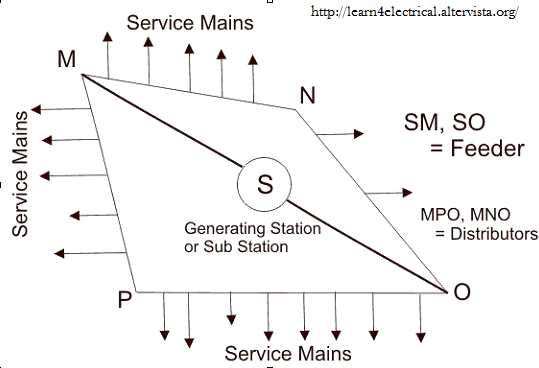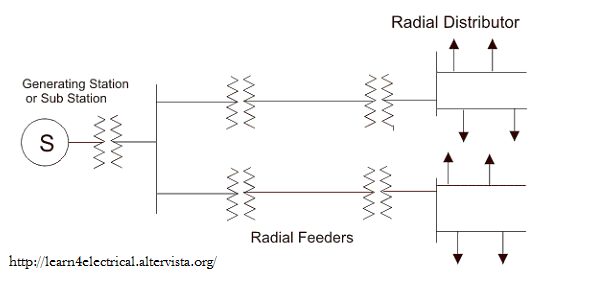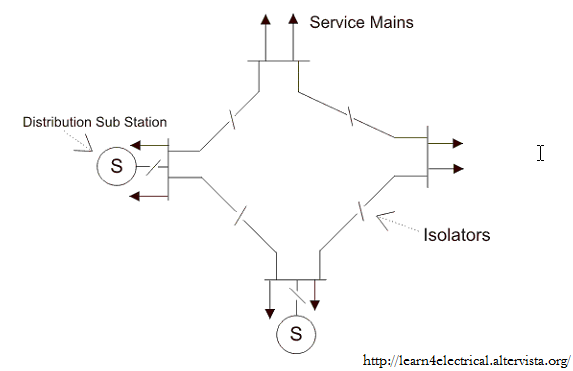Distribution networks consist of following main parts
⦁ Distribution substation,
⦁ Primary distribution feeder,
⦁ Distribution Transformer,
⦁ Distributors,
⦁ Service mains.
The transmitted electric power is stepped down is substations, for primary distribution purpose. Now these stepped down electric power is fed to the distribution transformer through primary distribution feeders. Over head primary distribution feeders are supported by mainly supporting iron pole (preferably rail pole). The conductors are strand aluminum conductors and they are mounted on the arms of the pole by means of pin insulators. Some times in congested places, underground cables may also be used for primary distribution purposes.
Distribution transformers are mainly 3 phase pole mounted type. The secondary of the transformer is connected to distributors. Different consumers are fed electric power by means of the service main. These service mains are tapped from different points of distributors. The distributors can also be re-categorized by distributors and sub distributors. Distributors are directly connected to the secondary of distribution transformers whereas sub distributors are tapped from distributors. Service main of the consumers may be either connected to distributors or sub distributors depending upon the position and agreement of consumers. In this discussion of electrical power distribution system, we have already mentioned about both feeders and distributors. Both feeder and distributor carry the electrical load, but they have one basic difference. Feeder feeds power from one point to another without being tapped from any intermediate point. As because there is no tapping point in between, the current at sending end is equal to that of receiving end of the conductor. The distributors are tapped at different points for feeding different consumers; and hence the current varies along their entire length.
Radial Distribution System
In early days of electrical power distribution system, different feeders were radially come out from the substation and connected to the primary of distribution transformer directly.
But radial electrical power distribution system has one major drawback that in case of any feeder failure, the associated consumers would not get any power as there was no alternative path to feed the transformer. In case of transformer failure also, the power supply is interrupted. In other words the consumer in the radial electrical distribution system would be in darkness until the feeder or transformer was rectified.
Ring Main Electrical Power Distribution System
The drawback of radial electrical power distribution system can be overcome by introducing a ring main electrical power distribution system. Here one ring network of distributors is fed by more than one feeder. In this case if one feeder is under fault or maintenance, the ring distributor is still energized by other feeders connected to it. In this way the supply to the consumers is not affected even when any feeder becomes out of service. In addition to that the ring main system is also provided with different section isolates at different suitable points. If any fault occurs on any section, of the ring, this section can easily be isolated by opening the associated section isolators on both sides of the faulty zone.
In this way, supply to the consumers connected to the healthy zone of the ring, can easily be maintained even when one section of the ring is under shutdown. The number of feeders connected to the ring main electrical power distribution system depends upon the following factors.
⦁ Maximum demand of the system : If it is more, then more numbers of feeders feed the ring.
⦁ Total length of the ring main distributors : It length is more, to compensate the voltage drop in the line, more feeders to be connected to the ring system.
⦁ Required voltage regulation : The number of feeders connected to the ring also depends upon the permissible allowable, voltage drop of the line.
The sub distributors and service mains are taken off may be via distribution transformer at different suitable points on the ring depending upon the location of the consumers. Sometimes, instead of connecting service main directly to the ring, sub distributors are also used to feed a group of service mains where direct access of ring distributor is not possible.


